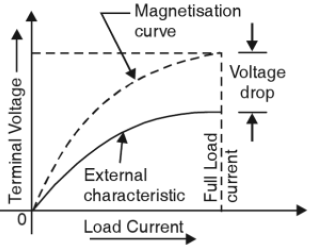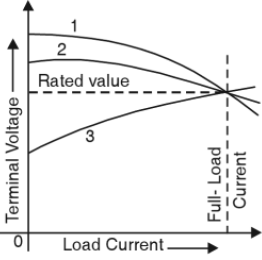
38. Fig. 1 shows the external characteristic of …….. generator.
(i) over-compounded
(ii) series
(iii) flat-compounded
(iv) shunt
Answer: (iv) shunt
39. Referring to Fig. 1, the voltage drop at no. 2 is due to
(i) friction
(ii) armature reaction
(iii) field circuit
(iv) none of the above
Answer: (ii) armature reaction

40. Fig. 2, shows the external characteristics of a …… generator.
(i) shunt
(ii) flat-compounded
(iii) series
(iv) over-compounded
Answer: (iii) series

41. Fig. 3 shows the external characteristics of three types of generators having the same rating. Curve 2 represents for generator.
(i) shunt
(ii) separately-excited
(iii) compound
(iv) none of the above
Answer: (ii) separately-excited
42. Curve 3 in Fig. 3 represents the external characteristic of a generator.
(i) compound
(ii) separately-excited
(iii) shunt
(iv) none of the above
Answer: (i) compound
43. Curve 1 in Fig. 3 represents the external characteristic of a generator
(i) shunt
(ii) series
(iii) flat-compounded
(iv)none of the above
Answer: (i) shunt

44. The curve B in Fig. 4 is the external characteristic of a generator.
(i) shunt
(ii) series
(iii) flat-compounded
(iv) under-compounded
Answer: (iii) flat-compounded
45. The curve A in Fig. 4 represents the external characteristic of …… generator.
(i) shunt
(ii) flat-compounded
(iii) under-compounded
(iv) an over-compounded
Answer: (iv) an over-compounded
46. The terminal voltage of a ……… generator vary widely with changes in load current.
(i) series
(ii) shunt flat-compounded
(iv)none of the above
Answer: (i) series
47. The effect of armature reaction is to
(i) decrease the total flux
(ii) increase the total flux
(iii) make the air-gap flux uniform
(iv) none of the above
Answer: (i) decrease the total flux
48. In a d.c. generator, armature reaction ……. pole tip.
(i) weakens the flux at the trailing
(ii) weakens the flux at the leading
(iii) strengthens the flux at the leading
(iv) none of the above
Answer: (ii) weakens the flux at the leading
49. The armature of a d.c. machine having 10 poles is rotating at a speed of 10 revolutions per second. The number of hysteresis loops formed per second is
(i) 100
(ii) 10
(iii) 150
(iv) 50
Answer: (iv) 50
50. The greatest percentage of heat loss in a d.c. machine is due to
(i) eddy current loss
(ii) hysteresis loss
(iii) copper loss
(iv) frictional loss
Answer: (iii) copper loss
51. The size of a d.c. generator can be reduced by using ………
(i) lap winding
(ii) high-resistance winding material
(iii) iron commutator
(iv) magnetic material of high permeability
Answer: (iv) magnetic material of high permeability
52. Hysteresis loss in a d.c machine is directly proportional to
(i) speed
(ii) (speed)2
(iii) (speed )1.6
(iv) none of the above
Answer: (i) speed
53. The physical size of 100 kW, 2000 r.p.m. generator is ……… that of 10 kW, 200 r.p.m. generator.
(i) more than
(ii) less than
(iii) about the same as
(iv) none of the above
Answer: (iii) about the same as
54. ……… together are called stray losses.
(i) copper and iron losses
(ii) iron and mechanical losses
(iii) field copper loss and iron loss
(iv) frictional loss and copper loss
Answer: (ii) iron and mechanical losses
55. The armature conductors of a 6-pole, lap-wound d.c. generator are divided into
(i) 2 parallel paths
(ii) 4 parallel paths
(iii) 3 parallel paths
(iv) 6 parallel paths
Answer: (iv) 6 parallel paths
56. The efficiency of a d.c. generator is maximum when its variable loss is
(i) equal to constant loss
(ii) equal to half of constant loss
(iii) equal to double the constant loss
(iv) none of the above
Answer: (i) equal to constant loss
57. In a cumulatively compounded generator, the shunt and series fields ……. each other.
(i) aid
(ii) oppose
(iii) sometime aid, sometime oppose
(iv) none of the above
Answer: (i) aid
58. Which of the following will not prevent a self-excited shunt generator from building upto its full voltage ?
(i) wrong direction of rotation
(ii) open field
(iii) no residual magnetism
(iv) speed too high
Answer: (iv) speed too high
59. The curve showing the relation between the terminal voltage V and load current IL of a d.c. generator is called its …….. characteristic.
(i) magnetic
(ii) external
(iii) internal
(iv) none of the above
Answer: (ii) external